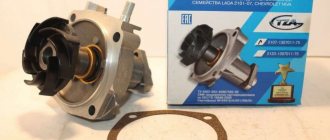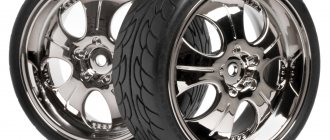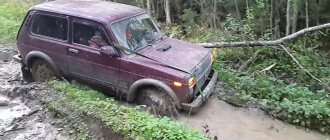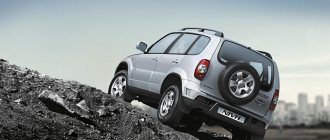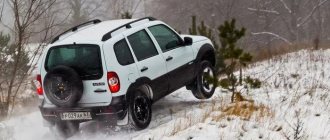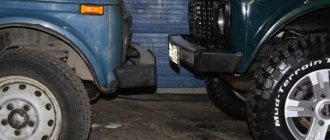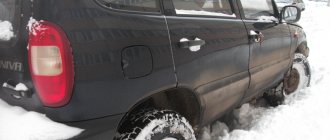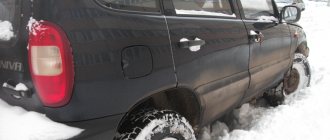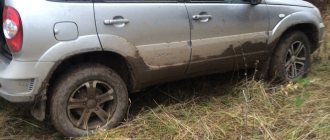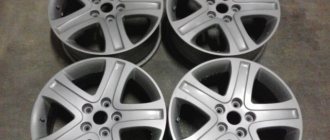Choosing the right tire size for a car means ensuring the longevity of all components and assemblies, as well as guaranteeing safety when driving on the roads. In this case, many factors must be taken into account: climatic conditions, road conditions, as well as your financial capabilities.
The tires installed on the car determine the cross-country ability, ground clearance, noiselessness and smoothness of driving on a broken road. When developing the car at the factory, taking these conditions into account, the following tire sizes were installed for various configurations:
| Equipment | Disc mounting diameter, inches | Drive dimensions in inches | Tire size |
| L, LG, GL | 15 | 6Jx15 | 205/75R15 205/70R15 |
| GLC, LE, LE+ | 16 | 6.5Jx16 | 215/65R16 |
The table shows that the wheel width for cars of different configurations is 6 and 6.5 inches. The diameter of the hole for mounting on the hub is 98.5 mm, fastening to the hub using 5 M12x1.5 bolts located at a diameter of 139.7 mm. All discs have a distance between the hub and the rim surface of 40 mm.
The tire designation means the following: 205 or 215 tire width in mm, 65 or 70 a value characterizing the height of the tire rim, otherwise it is called the profile. R15 or R16 tire inner diameter in inches.
What pressure should be set in tires
Setting normal tire pressure will reduce vehicle maintenance costs by reducing fuel consumption and tire wear. In addition, the driving safety and maneuverability of the vehicle depend on the tire pressure.
The tire pressure for cars with an R 15 rim should be 1.9 kg/cm², and for a R16 rim, slightly higher than 2.0 kg/cm². On Chevrolet Niva cars with 4x4 axles in off-road conditions, as well as in winter when driving on loose snow, you can reduce the pressure to 1.2-1.5 kg/cm². On a flat, high-speed highway, many increase tire pressure by 0.1-0.2 kg/², although this leads to stiffer car suspension and reduces ride comfort.
Using a vehicle with tire pressures other than normal can lead to the following consequences:
- Increased wear on the vehicle's suspension and chassis parts.
- Driving on a flat tire will increase gas mileage because the tire has more contact with the road surface and the engine needs to develop more power. Due to this, tire wear will increase.
- With high tire pressure, contact with the road decreases and driving becomes unsafe, especially in winter.
What tire sizes does the manufacturer recommend to install?
The choice of tires is a real problem for most Chevrolet Niva owners due to the fact that the “range of sizes” is limited. Driving for a long time on tires with inappropriate sizes leads to decreased vehicle control and emergency situations.
| Wheel disks | Tires |
| L, LG, GL 15 6Jx15 ET45 | 205/75R15 |
| GLC, LE, LE+ 16 6.5Jx16 ET44 | 205/70R15, 215/65R16 |
The abbreviation stands for as follows:
- wheel rim width;
- surface diameter;
- reach length;
- tire width;
- height in percent;
- diameter of the metal rim.
The higher the disc is installed on the car, the greater the risk of skidding and reduced control efficiency. At the same time, excessively low wheels also negatively affect ground clearance, lower ground clearance, and limit the vehicle’s maneuverability.
What off-road tires should I put on a Chevrolet Niva?
For off-road conditions, the Chevrolet Niva is equipped with M/T tires. It is not suitable for asphalt due to high noise, poor handling and rapid wear, but it is perfect for dirt, country roads, fields, and swamps. This tire is made from special rubber and is very soft. Off-road tires maintain low pressure perfectly, and at the same time they are not damaged when colliding with rocks. M/T tires for Chevrolet Niva are most often represented by such models as I-569 Medved, Cordiant off Road, Hankook Dynapro MT RT03.
Off-road tires
Standard 16" tire options
The standard tire size for Niva is quite unique - 18575R16 - narrow and tall tires of 16 diameter. Not many manufacturers produce tires of this size, and even fewer produce narrow and tall winter tires of 16 diameter.
Which winter tires to prefer for the Niva - studded or not - each car owner decides for himself (on our website there is an article to help: Velcro or studs).
Since the Niva is primarily an SUV, studded tires are most often selected for it.
Among studded tires, one of the most popular are Voltyre VLI-5 and VLI-10. Tires of this particular brand are installed at the factory, so this option is the most inexpensive. But not the most optimal, since the driving characteristics of these tires leave much to be desired.
For standard sizes you can also find winter studded tires of such models as:
- Amtel K182A (Seven Hills)
- Cordiant Business
- Gislaved NordFrost Van
- Nokian Nordman C
- Nokian Hakkapeliita C Cargo
- Michelin Agilis X-ice North
- Good Year Cargo Ultra Grip
Among the non-studded options for the standard Niva size you can find tires of the following models:
- KShZ K182A (Amtel Seven Hills)
- Kama Euro LCV
- Rosava LTW
- Viatti Vettore Brina
- Belshina Bravado
- Tigar Cargo Speed
- Yokohama W.Drive
- Hankook Winter Ipike
- Continental VanContact
- Nokian WRC3
However, it is worth mentioning that except for the domestic Amtel, Cordiant and Kama, as well as the Ukrainian Rosava and Belarusian Belshina, all other tires will be quite expensive, so most Niva owners will not consider them as winter tires for their car. Because instead of these expensive 16-radius tires, you can install 15-radius tires, which will cost significantly less.
Basic equipment
In the basic configuration, the Chevrolet Niva is equipped with tires with parameters 185/75 R16 92Q 95T and 175/80 R16.
This option has a number of disadvantages:
- At speeds above 60 km/h the noise increases.
- Loss of elasticity in the cold.
- Deterioration in handling on dry roads.
This is interesting: What is disk ejection?
Standard 16" tire options
The standard tire size for Niva is quite unique - 185\75\R16 - narrow and tall tires of 16 diameter. Not many manufacturers produce tires of this size, and even fewer produce narrow and tall winter tires of 16 diameter.
Which winter tires to prefer for the Niva - studded or not - each car owner decides for himself (on our website there is an article to help: Velcro or studs).
Since the Niva is primarily an SUV, studded tires are most often selected for it.
Among studded tires, one of the most popular are Voltyre VLI-5 and VLI-10. Tires of this particular brand are installed at the factory, so this option is the most inexpensive. But not the most optimal, since the driving characteristics of these tires leave much to be desired.
For standard sizes you can also find winter studded tires of such models as:
- Amtel K182A (Seven Hills)
- Cordiant Business
- Gislaved NordFrost Van
- Nokian Nordman C
- Nokian Hakkapeliita C Cargo
- Michelin Agilis X-ice North
- Good Year Cargo Ultra Grip
Among the non-studded options for the standard Niva size you can find tires of the following models:
- KShZ K182A (Amtel Seven Hills)
- Kama Euro LCV
- Rosava LTW
- Viatti Vettore Brina
- Belshina Bravado
- Tigar Cargo Speed
- Yokohama W.Drive
- Hankook Winter Ipike
- Continental VanContact
- Nokian WRC3
However, it is worth mentioning that except for the domestic Amtel, Cordiant and Kama, as well as the Ukrainian Rosava and Belarusian Belshina, all other tires will be quite expensive, so most Niva owners will not consider them as winter tires for their car. Because instead of these expensive 16-radius tires, you can install 15-radius tires, which will cost significantly less.
The best mud tires for Chevrolet Niva
Fans of active recreation have to overcome difficult sections of roads that pass through water meadows and forests. In such operating conditions, it is optimal to use mud tires. Here are a few tires suitable for the Chevrolet Niva.
Toyo Open Country A/T plus
For those Chevrolet Niva owners who like to overcome real off-road conditions, Toyo Open Country A/T plus tires are addressed. Experts gave it the palm for its well-balanced balance of basic performance characteristics. A long service life for tires is ensured by a special rubber compound to which silicon oxide is added. The aggressive asymmetric tread pattern also gives the tires increased resistance to wear. Characteristic features are rigid blocks that form 5 ribs. When driving on asphalt, there is a sharp reaction to the rotation of the steering wheel; the tires handle well even in mud.
Domestic motorists in their reviews speak flatteringly about the softness of Japanese tires. The tires are not very noisy; driving on the highway is comfortable.
Advantages
- high wear resistance;
- strength;
- good handling;
- excellent cross-country ability.
Flaws
- light felling.
Continental ContiCrossContact AT
Summer tires Continental ContiCrossContact AT are very popular among Chevrolet Niv owners. Experts explain the steady demand for tires in Russia by their resistance to aquaplaning, low noise levels, and good cross-country ability. Open tread blocks are responsible for confident off-road driving. The manufacturer has specially selected a new rubber composition; it is characterized by increased wear resistance and effectively resists damage. The tires demonstrate timely removal of water from the contact patch, thereby reducing the risk of aquaplaning. The model takes second place in our review.
Users are satisfied with the balance of the rubber, but at the same time note such disadvantages as rutting on asphalt and high price.
Advantages
- good maneuverability;
- low noise;
- resistance to aquaplaning;
- wear resistance.
Flaws
- high price;
- rutting on asphalt.
GOODYEAR Wrangler All-Terrain Adventure With GOODYEAR
At any moment, a Chevrolet Niva, “shod” in GOODYEAR Wrangler All-Terrain Adventure With Kevlar tires, can go on a difficult journey. The tires are not only good off-road, they also perform well on asphalt. The Kevlar reinforcing layer reliably protects tires from damage; DuraWall technology is used to strengthen the sidewalls. The open side blocks effectively remove dirt and provide excellent traction. Experts claim increased mileage (up to 30%) compared to competitors. The model receives bronze in our review.
Russian tire drivers praise the tires for their good cross-country ability and stable behavior on the highway and gravel roads. Among the disadvantages, we can highlight the strong ejection of stones and uneven wear of the tread (the sidewalls are eaten faster).
Advantages
- good maneuverability;
- high strength;
- directional stability;
- low noise level.
Flaws
- uneven wear;
- strong ejection of stones.
Kumho Road Venture M/T KL71
In the catalog of the famous Korean manufacturer of automobile tires Kumho there is a mud model Road Venture M/T KL71, suitable for the Chevrolet Niva (215/75 R15). There will be no problems with installing tires, and there will be no need to make modifications to the design of the wheel arches. Experts are pleased with how the tires behave in mud; the tread effectively cleans itself. Experts attribute softness to the advantages of rubber, thanks to which the tires do not make noise, despite their heavy weight. The weakness of Korean tires is the rapid wear of the tread, which is noticeable when driving on asphalt. Therefore, the rubber stops one step away from the top three.
In reviews, motorists praise Korean tires for easy balancing, directional stability at high speed, and excellent behavior on wet surfaces.
Advantages
- efficient off-road operation;
- noiselessness;
- well balanced;
- stability on the road.
Flaws
- wears out quickly.
Attention! This rating is subjective in nature, is not an advertisement and does not serve as a purchase guide. Before purchasing, consultation with a specialist is required.
Which all-season vehicle for Niva 4x4 is better?
It is a well-known fact that you can’t install winter tires in the summer, as they will begin to melt due to high temperatures, and in the winter you can’t install summer tires, because you can’t avoid trouble on the road in icy conditions. All-season optimal tires size r16 for Niva 21213 4x4. The main manufacturers of all-season 4x4 tires are: Kumho (South Korea), Cordiant, and domestic ones: Belshina OJSC and Nizhnekamskshina. The latter brand is widely known throughout Russia.
The Cordiant brand produces all-season tires for Niva in 15 and 16 inches. Thanks to the solid base of all-season wheels of sizes r15 and r16, the model is protected from any minor damage. According to reviews from car owners of 4x4 size r16 all-season vehicles using this type, they talk about the following advantages: cross-country ability, accessibility and softness when driving in any weather.
Another tire model is Toyo Open Country A/T Plus. This tire is suitable for both off-road and asphalt roads. The cost of tires is about 4000 rubles. Due to the wide drainage channels existing in these tires, moisture and dirt are easily removed.
When choosing an all-season tire, it is better to follow the recommendations from the manufacturer and do not forget that such tires will have to be changed more often than summer or winter tires.
ABOUT COMPATIBILITY OF TIRES AND WHEELS
If you decide to replace the standard wheels and tires on a Chevrolet (LADA) Niva, then rely on the full diameter of the wheel. How to do this, using the example of 205/70 R15:
- A disk with a diameter of 15″ is equal to 15 * 25.4 (1 inch = 2.54 cm) = 381 mm.
- The height of the tire profile is calculated as follows: 205*70/100=143.5 mm.
- Add up the rim diameter and two tire profile heights: 381 + 143.5 * 2 = 668 mm.
In order not to perform such calculations, we post a compatibility table for tires and wheels for the Chevrolet Niva (left for 205/70R15, right for 215/60R17):
Green
the minimum deviation of the wheel diameter is indicated (up to 3 mm);
Orange
indicates a diameter deviation from 3 to 6 mm.
We can determine the width of the rim using the table:
When installing tires or wheels that differ in parameters from those recommended by the factory, you can:
- be refused warranty repair of the chassis;
- be stopped by a traffic police inspector, who has the right to draw up a report on the car’s non-compliance with the requirements of the Technical Regulations;
- fail to pass technical inspection.
Attention!
Installing larger wheels may lead to problems with ABS and ESP calibration (the systems may not work correctly).
The best summer tires for Chevrolet Niva
From spring to autumn, it is best to drive a Chevrolet Niva on summer tires. Especially when the daily route runs along city streets or country roads. Experts liked the following tire models.
Yokohama BluEarth-Van RY55
Summer tires Yokohama BluEarth-Van RY55 are designed for use on commercial vehicles, crossovers and SUVs. The element of rubber is city streets and country roads. In such conditions, the tires feel confident on both dry and wet asphalt. Experts note fuel efficiency, which should please Chevrolet Niva owners. Japanese designers worked out the tread pattern in detail, this made it possible to increase directional stability and reduce rubber deformation in the transverse direction. Domestic motorists also express their solidarity with the experts, making the model the winner of our review.
The main advantages of tires, according to users, are softness, wear resistance, and good balancing.
Advantages
- directional stability;
- affordable price;
- resistance to transverse deformation;
- fuel efficiency.
Flaws
- not detected.
Continental CrossContact ATR
A successful balance between the main performance qualities allowed the Continental CrossContact ATR summer tires to win silver in our review. German tires are designed for crossovers and SUVs. The tread pattern has an unusual look for the brand. In the center there is a large number of blocks, united in groups of threes. They are responsible for directional stability and excellent traction and grip properties. If the central part is flexible, then the shoulder areas have a rigid connection. This structure increases efficiency during acceleration, maneuvering and braking.
Positive assessments prevail in reviews of Russian consumers. Car enthusiasts like tires for their versatility, noiselessness, and tenacity. The downside is the high price.
Advantages
- good handling;
- noiselessness;
- effective braking;
- resistance to aquaplaning.
Nokian Tires Nordman SX2
Finnish tire manufacturer Nokian Tires has released a new line of summer tires Nordman SX2. They replaced the popular Hakka Green series. Accordingly, experts expect the same good performance properties. The strengths of tires include reliability and durability. The rubber demonstrates excellent grip and excellent handling. The scope of application of tires is passenger cars of low and medium power; the Chevrolet Niva can also be included in this category. The optimal combination of price and quality helped the model get to the top spot in our review.
Users praise Finnish tires for their good road grip, excellent roll-up, and low noise. The disadvantages include not very good balancing and rapid wear.
Advantages
- reliability and durability;
- excellent grip;
- good handling;
- noiselessness.
Flaws
- poorly balanced;
- wears out quickly.
MICHELIN Latitude Cross
The French manufacturer of car tires MICHELIN has created a line of summer tires for SUVs and crossovers. Latitude Cross tires feel confident both on asphalt surfaces and on country dirt roads. According to experts, rubber can be called universal, since high grip properties ensure effective passage of off-road areas. The reason for this versatility lies in the asymmetric tread pattern, which combines an extensive network of grooves and multidirectional blocks. The rubber composition also has high wear resistance.
The tires stopped just short of the podium due to the high price and high noise level. Users most often praise rubber for its versatility, grip and comfortable handling of uneven surfaces.
Advantages
- versatility;
- good traction and grip properties;
- wear resistance;
- no aquaplaning.
Flaws
- high price;
- noisiness.
Profile height
The height of the rubber profile affects the comfort, rigidity, reliability of the car and the load.
Increasing the height makes the car more comfortable and softer, and increases the landing position. But when the permissible height is exceeded, controllability deteriorates, braking distance increases, fuel consumption increases, and additional load appears on the vehicle’s chassis.
Reducing the profile height improves the car's handling, but the car becomes stiffer and the ride less comfortable. In addition, the risk of puncture increases.
General tire parameters
The industry produces different types of tires, which differ in size, tread pattern and other parameters. They can be identified by the markings that are applied to the side surface of the tires.
Size
Manufacturers indicate three parameters that determine the tire size:
- Inner diameter in inches.
- Tire width.
- The ratio of the height of the product to the width in percentage (rubber profile).
These parameters are indicated in the following order: width, profile, diameter. For example, the marking 185/65 R15 means the following:
- Tire width is 185 millimeters.
- The profile height is 120 mm (65% of 185 mm).
- The landing (inner) diameter is 15 inches.
The size of tires affects their performance properties. The area of the contact patch with the road surface is proportional to the width of the rubber. The larger it is, the better the grip and the shorter the braking distance.
Also, wide wheels reduce the specific pressure on the ground, thereby increasing off-road capability. However, too wide tire width also has disadvantages:
- The wider the tires, the higher the rolling resistance. This worsens dynamics and increases fuel consumption.
- A large contact patch increases the likelihood of aquaplaning. It is better to drive through puddles on the asphalt on narrow tires.
- Geometric dimensions determine the weight of the rubber. As the weight of the wheels increases, the load on the suspension increases.
- Wide tires are more expensive than their narrow counterparts.
- Less ground pressure worsens vehicle handling on country roads.
Profile width
Parameters such as controllability and safety depend on the width of the profile.
Increasing the profile width improves vehicle handling, especially at high speed, reduces braking distance, and enhances directional stability. At the same time, high-profile tires are more expensive and increase the risk of aquaplaning and fuel consumption.
Reducing the profile width improves traction on snowy roads or in ruts and reduces fuel consumption. The disadvantages of a narrow tire include worse handling, decreased stability, and increased braking distance. It is highly not recommended to install tires already recommended by the manufacturer.
Price for a set of winter tires
When choosing suitable winter tires, you should pay attention to its cost and compare it with the budget that you are willing to allocate for it. Today the market offers models of three price classes - low, middle and premium. At the same time, within each of them, products are ranked depending on the authority of the brand.
The lower price category includes brands such as Cordiant or Kumho. The cost of their tires for the cold season ranges from 3-4.5 thousand rubles per piece. Prices in the middle price category, which includes Nordman, BF Goodrich or Nokian, range from 5-8 thousand rubles. And over 8 thousand sell premium-segment wheels.
